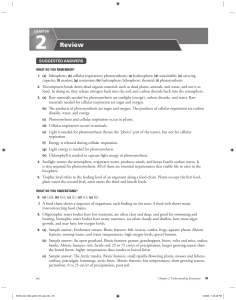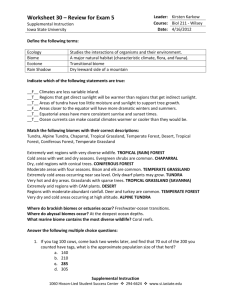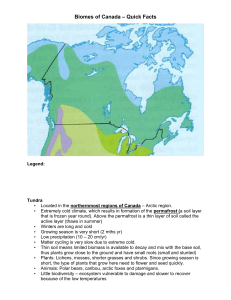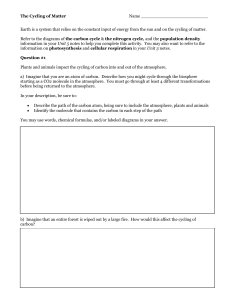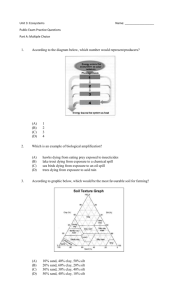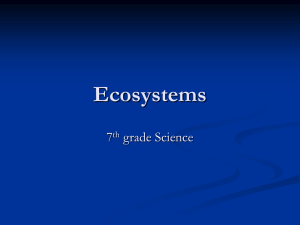Chapter 2 Review What Do You Remember? 1. (a) lithosphere (b
advertisement
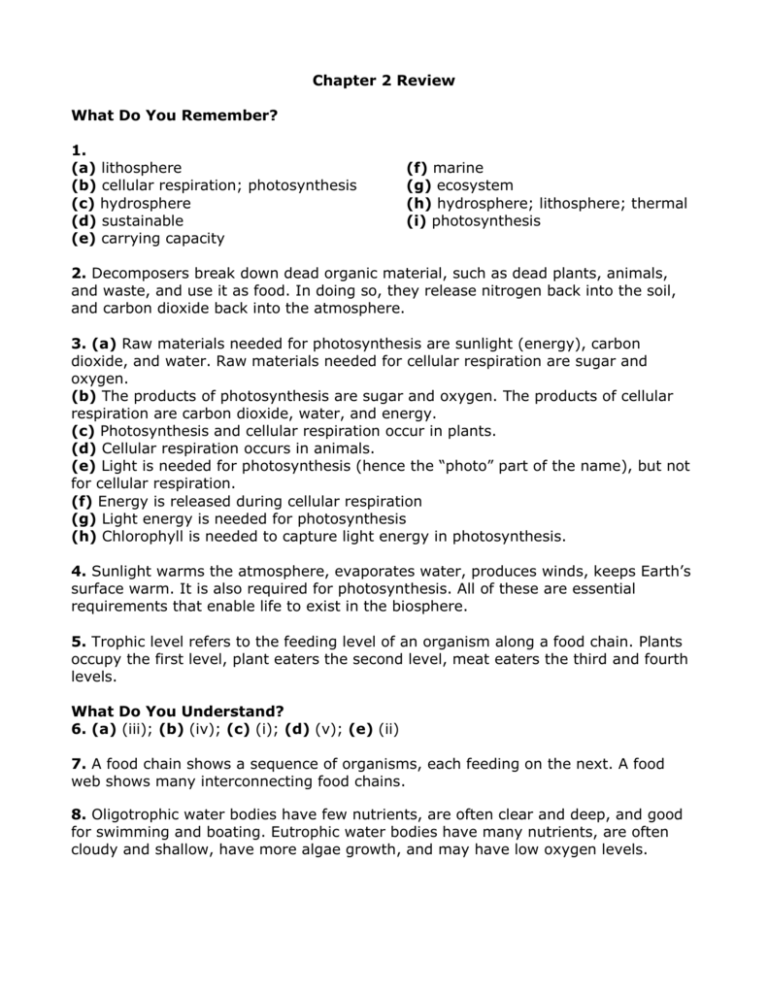
Chapter 2 Review What Do You Remember? 1. (a) lithosphere (b) cellular respiration; photosynthesis (c) hydrosphere (d) sustainable (e) carrying capacity (f) marine (g) ecosystem (h) hydrosphere; lithosphere; thermal (i) photosynthesis 2. Decomposers break down dead organic material, such as dead plants, animals, and waste, and use it as food. In doing so, they release nitrogen back into the soil, and carbon dioxide back into the atmosphere. 3. (a) Raw materials needed for photosynthesis are sunlight (energy), carbon dioxide, and water. Raw materials needed for cellular respiration are sugar and oxygen. (b) The products of photosynthesis are sugar and oxygen. The products of cellular respiration are carbon dioxide, water, and energy. (c) Photosynthesis and cellular respiration occur in plants. (d) Cellular respiration occurs in animals. (e) Light is needed for photosynthesis (hence the “photo” part of the name), but not for cellular respiration. (f) Energy is released during cellular respiration (g) Light energy is needed for photosynthesis (h) Chlorophyll is needed to capture light energy in photosynthesis. 4. Sunlight warms the atmosphere, evaporates water, produces winds, keeps Earth’s surface warm. It is also required for photosynthesis. All of these are essential requirements that enable life to exist in the biosphere. 5. Trophic level refers to the feeding level of an organism along a food chain. Plants occupy the first level, plant eaters the second level, meat eaters the third and fourth levels. What Do You Understand? 6. (a) (iii); (b) (iv); (c) (i); (d) (v); (e) (ii) 7. A food chain shows a sequence of organisms, each feeding on the next. A food web shows many interconnecting food chains. 8. Oligotrophic water bodies have few nutrients, are often clear and deep, and good for swimming and boating. Eutrophic water bodies have many nutrients, are often cloudy and shallow, have more algae growth, and may have low oxygen levels. 9. (a) Freshwater stream: Biotic features: fish, insects, turtles, frogs, aquatic plants. Abiotic features: moving water, cool water temperatures, high oxygen levels, gravel bottom. (b) An open grassland: Biotic features: grasses, grasshoppers, bison, voles and mice, snakes, hawks. Abiotic features: rich, fertile soil, 25 to 75 cm/yr of precipitation, longer growing season than the boreal forest, higher temperatures than tundra or boreal forest (c) The Arctic tundra. Biotic features: small rapidly-flowering plants, mosses and lichens, caribou, ptarmigan, lemmings, arctic foxes. Abiotic features: low temperatures, short growing season, permafrost, 0 to 25 cm/yr of precipitation, poor soil 10. (a) Herbivores compete against each other by eating the same grasses or plants. (b) Carnivores compete against each other by hunting and eating the same prey. (c) Producers compete against each other by competing for sunlight, soil nutrients, and water. 11. Plants get new energy from the Sun. 12. th 4 (top) level – owls- 8 rd 3 level – shrews, moles - 95 nd 2 st level – grasshoppers, snails, slugs – 39 000 1 (lowest) level – grass plants – 100 000 13. The energy originates from the Sun. It was trapped and converted to chemical energy by producers (plants) at the first trophic level and then has been passed along the food chain from one trophic level to the next. At each trophic level some of the energy is lost when it is used by the organism or released as waste energy. 14. Phytoplankton: producer; zooplankton: herbivore; whale: omnivore; mussel: omnivore; small fish: carnivore; starfish: carnivore; lobster: carnivore; gull: carnivore; large fish: carnivore; squid: carnivore; dolphin: carnivore; seal: carnivore 15. First trophic level: phytoplankton Second trophic level: zooplankton Third trophic level: whale, small fish, mussel Fourth trophic level: squid, large fish, lobster, starfish, gull, seal, dolphin secondary consumers: squid, large fish, lobster, dolphin primary consumers: whale, small fish, mussel zooplankton phytoplankton 16. Dolphins and seals would be directly affected by the over-harvesting of large fish. 17. The elimination of whales would mean there would be more zooplankton, which would mean more mussels and more starfish. It would also mean more small fish, which would mean more squid. 18. If the seal population increased, squid, large fish, and small fish would decrease, which would mean that dolphins and lobsters might decrease. If lobsters decreased, gulls might decrease, but mussels might increase, which means zooplankton might decrease, and whales might decrease, which means phytoplankton might increase. 19. (a) amount of precipitation: deciduous forest, grassland, boreal forest, tundra (b) average temperature: deciduous forest, grassland, boreal forest, tundra (c) length of growing season: deciduous forest, grassland, boreal forest, tundra (d) biodiversity: deciduous forest, grassland, boreal forest, tundra (e) total biomass: deciduous forest, boreal forest, grassland, tundra The reasoning is that the warmer and wetter the biome, the greater productivity and biodiversity. Growing seasons are longer as you move toward the equator. 20. In the tundra there is a much shorter growing season and cooler temperatures so all biological processes like photosynthesis and cellular respiration are reduced and slowed down. In the tundra, some of the carbon is also locked up in the permafrost. Solve a Problem 21. Table 2 Precipitation low medium high Temperature low medium high Possible biomes tundra boreal forest, grasslands temperature deciduous forest 22. The biome might be boreal forest or grassland. It is difficult to tell because both biomes could sometimes have 35-50 cm of precipitation and an average temperature of 10ºC.
